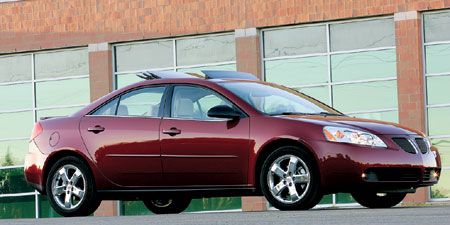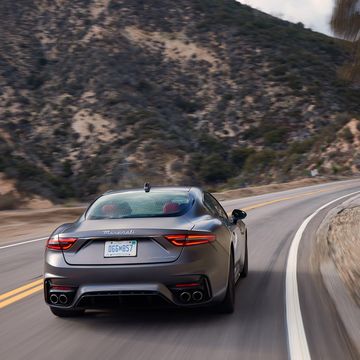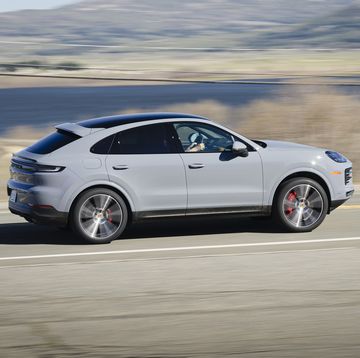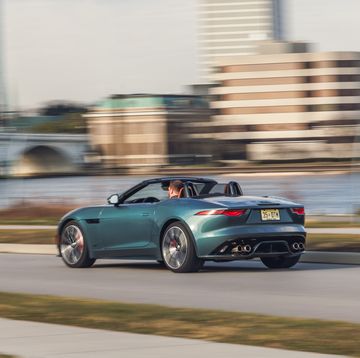As the replacement for the dated Grand Am--a car that last underwent a major revision in 1999--the Pontiac G6 is shouldered with the unenviable dual role of slayer and savior. Sort of a Kevorkian of automobiles, the G6 gets to kindly kill off the long-running Grand Am after the 2005 model year (Pontiac is offering a limited run of Grand Am coupes for '05) and strengthen Pontiac's image as the maker of "excitement."
It's no secret the Grand Am has been a disappointment to the enthusiast crowd. Shuffle through your old Car and Drivers, and you'll find that the last time a Grand Am competed in a comparison test here was in February 1996. In that eight-car shootout, it fired a decided blank, finishing eighth. Since then, we haven't had sufficient reason to invite a Grand Am back, despite the freshening it received in '99. Here at C/D, we seek to compare the top cars in any given segment, and the Grand Am was simply not a contender.
Nonetheless, the Grand Am has been a hit in the marketplace, continually managing to be Pontiac's bestseller. Through October 2004, Pontiac sold more than 160,000 Grand Ams, which is 32 percent of the division's sales. And since its overhaul in 1999, the Grand Am has found more than one million takers, with nearly 235,000 sold in that year alone. In beancounter circles, this is bliss. Still, about 30 percent of those sales came not from the Joneses and Smiths but rather from the Hertzes and Avises.
And so the G6 is expected to continue to be Pontiac's volume leader, with the division aiming to sell about 200,000 annually. Eventually, there will be a coupe, a retractable-hardtop convertible, an entry-level sedan with a 2.4-liter Ecotec four-cylinder, and a high-performance four-door with a more potent V-6. Pontiac is hoping to downgrade fleet sales to about 10 percent of the mix, which means that, unlike the Grand Am, the G6 has to be a legitimate contender in its segment.
The new G6 opens at $21,300, and for that you get a 200-hp V-6, a four-speed automatic, 16-inch wheels, and disc brakes at all four corners. The $23,925 GT ups the ante with a sport suspension, 17-inch wheels, ABS, traction control, power-adjustable pedals, a rear spoiler, and an eight-speaker Monsoon stereo. For this test, we asked for a GT version, and Pontiac promptly answered with a $28,125 example dressed in Sport Red Metallic paint and equipped with leather-covered seats, curtain airbags, the OnStar communications system, an in-dash six-CD changer, and a giant four-pane sunroof big enough to frame three exotic dancers performing a drive-by. Gee-Six!
One look at this new Pontiac and it's clear that design manager Jeff Perkins sought to make a bold statement, one that would catch the eyes of prospective buyers who tend to be partial to imports, e.g., the Honda Accord, the Mazda 6, and the Toyota Camry. Without the Grand Am's celebrated and mocked body cladding, the G6 now has a clean, sleek skin that, combined with a rakish beltline and ski-slope hood, gives it an aggressive, fast-forward stance. For Perkins, it was essential the G6 possess dynamic proportions; thus, it features a stretched wheelbase sandwiched by a short rear overhang and long front overhang.
The exterior redesign carries over inside, where the interior is noticeably more slick than the Grand Am's. We were impressed with the G6's ergonomics, fit and finish, and high-quality plastics--most of which are nicely grained and soft to the touch--and aesthetically pleased by the two-tone beige-and-black ambience. The panoramic roof functioned without a glitch, the three back panes smoothly sliding and stacking rearward, the front popping up to serve as a wind deflector. If we had our druthers, we'd replace the way-bright chrome surrounds on the gauges with brushed rings and find better-shaped, more supportive seats. As they are, the fronts lack the firm-hug feel of proper sport chairs, and the rear bench, although a La-Z-Boy sofa compared with the Grand Prix's park bench, features a seat cushion too flat and short.
The G6's long wheelbase is identical to the 112.3-inch span that separates the front and rear axles of the Chevy Malibu Maxx, a wagon that shares GM's front-drive Epsilon architecture with the Saab 9-3, the Malibu sedan, and now the G6. Rather than utilize the 9-3's 105.3-inch wheelbase or the Malibu's 106.3-inch spread, Pontiac opted for the Maxx-imum extension, which gives the G6 its wheels-pushed-to-the-corners look, as well as 37.6 inches of rear legroom, an inch more than an Accord has. Parked next to a Grand Am, the G6, at 189.1 inches, is nearly three inches longer, just 0.1 inch shorter than a Camry. Between the lines, the G6 shades 68.9 inches side to side, almost two inches narrower than the Camry.
The G6 is suspended by struts up front and a four-link independent setup in back. Compared with the standard G6, our GT tester featured larger-diameter anti-roll bars, 17-inch "chrome tech" alloy wheels, bigger front brake rotors, and sport-tuned dampers and springs.
Equipped with this so-called sport suspension, we expected the GT to be, well, sporty. It wasn't. Hustled around our 10Best handling route, the G6 displayed expected levels of moderate understeer, but it felt more floaty than sporty, its legs too yielding to carve up the road in the manner of a front-wheel-drive sports sedan like the Mazda 6 s. Our GT's rack-and-pinion helm lacked the direct, positive feel that builds confidence, be it cornering or cruising, instead communicating a disconnected sense on-center and numbness through turns. So, although the G6 recorded an above-average roadholding number of 0.81 g--superior to an Accord EX V-6 (0.74) but inferior to a Mazda 6 s (0.84)--it never afforded us the confidence or comfort level to want to reach for its limits on public roads. The four-wheel disc brakes with standard ABS did little to help, despite offering a firm pedal feel. Stopping from 70 to 0 mph required 185 feet--about the same as its competitors.
On the bright side, the G6's forgiving suspension delivered a supple, comfortable ride, even over the ragged, uneven roads outside Ann Arbor's city limits. In fact, even the roughest stretches we traversed did nothing to stress the stout structure, much less upset the chassis, which soaked up bumps without inflicting bruises or raising concerns.
At the drag strip, the 200-hp G6 dragged more than we predicted, posting a 0-to-60 sprint of 7.9 seconds and a quarter-mile time of 16.1 at 86 mph, both slower than the 240-hp Accord (7.0 and 15.5) and the 220-hp Mazda 6 s (6.8 and 15.4). The G6 did manage to outgun the last Camry SE V-6 we tested (8.2 and 16.4), although that model's 192 horsepower is 33 short of the '05 Camry SE's. The G6's 3.5-liter, 12-valve pushrod engine is not as refined as the competition's 24-valve overhead-cam units, but it's an able motor that delivers a respectable 220 pound-feet of torque as well as 21 mpg city and 29 mpg highway. Mash the throttle, and the four-speed automatic doesn't shy away from revving its partner to successive 5800-rpm shifts. Just be willing to wait for those shifts to occur--the gearing gaps are canyonlike. Unfortunately, the 3.5 also doesn't shy away from emitting a resonance that grates as the tach creeps skyward. Those accustomed to the sweet song of an Accord V-6 will cringe.
The big culprit for the G6's lackluster performance is heft--the Pontiac weighs 3532 pounds. By comparison, an Accord EX V-6 weighs 3439; a 6 s, 3329; and a Camry SE V-6, 3424. Even the Malibu Maxx, with its fifth door, tips the scales at 3460. Why's the G6 so heavy? For one, its iron-block V-6 is like an anchor under the bow, and the sunroof, with its electric motor and four glass panes, is akin to a lead hat.
Although there's little hope of upcoming weight reductions for the G6, more power appears to be on the horizon. At last November's SEMA show in Las Vegas, Pontiac unveiled a GXP "concept" that tempted enthusiasts with a 275-hp, 3.6-liter V-6; a six-speed manual; and Bilstein dampers. If--sorry, when--the GXP goes on sale, it promises to deliver what the GT could not--a real sports-sedan experience.
Until then, the GT is as sporty as the G6 comes. For those considering an upgrade from their Grand Ams, this isn't a bad thing. The G6 will no doubt turn all fond feelings toward the Grand Am into distant dislikes. But for those cross-shopping the G6 GT with the Japanese competition, the new Pontiac may possess the looks, but it still lacks the refinement and, in most instances, robust performance.
Now that the Grand Am has one foot in the grave, all that's left for the G6 is to make the driver feel alive. Let's hope the upcoming GXP can do the job.
TONY SWAN
The G6 is an all-new car, yet many Grand Am traditions linger on. Pontiac has dispensed with the stick-on surface excitement (read "plastic cladding"), but the performance doesn't measure up to the visual promise. The badging says GT, but the steering feels as if it were crafted by carpenters, transient response is reluctant, grip is modest, understeer ranges from mulish to terminal, braking is only adequate, and the power of the pushrod six is, to be kind, anemic. All of these good old Grand Am traits are baked into a sexy new package with an interior that looks terrific. Wouldn't it be swell if Pontiac could get the dynamics marching to the same beat?
DAVE VANDERWERP
For this, my first-ever counterpoint, I expected the "first ever" G6 would be a substantial improvement over its unloved predecessor, the Grand Am. Guess again. Despite a better power-to-weight ratio than the current Grand Am GT (which, in case you were wondering, is the third ever), the G6 is slower to 60 mph and the quarter-mile, takes longer to stop from 70 mph, and has less skidpad grip. Since the G6 isn't any more of a driver's car than the Grand Am, the best thing about the G6 is that the stylish looks will make me considerably less aggravated when one of these, rather than a Grand Am, is blocking the left lane.
AARON ROBINSON
GM does modest cars that meet modest expectations. The new Pontiac battles its heritage with some pricey-car details such as painted and chromed accents and a fine-weave headliner. No gaping fissures or wobbly trim on this dash; it looks solid, a sculpted monoblock wrapped in a squishable skin. Compound hinges swing the trunk up and away, exposing an airport-ready trunk. Pushing the axles farther apart draws applause from passengers, although rear headroom is cut short by the sunroof machinery. Dull handling, the chug of pushrods, and some absurd seat lumpiness mean only folks with modest expectations will see the G6 as a great leap forward.

















